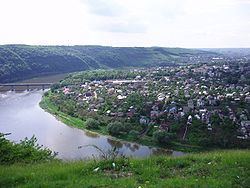Country Ukraine Raion Zalishchytskyi Time zone EET (UTC+2) Population 9,750 (2007) Team FC Dnister Zalishchyky | Oblast Ternopil First mentioned 1340 Area 7.16 km² Local time Saturday 11:08 PM | |
 | ||
Weather 13°C, Wind SE at 13 km/h, 69% Humidity | ||
Zalishchyky (Ukrainian: Залiщики, also Zalishchyky, Polish: Zaleszczyki) is a small city located on the Dniester river in the southern part of the Ternopil Oblast (province), in western Ukraine. It is the administrative center of the Zalishchyky Raion (district).
Contents
- Map of Zalishchyky Ternopil Oblast Ukraine
- Geography
- History
- Archeology and monuments
- Points of interest
- People
- Twin towns Sister cities
- References
Map of Zalishchyky, Ternopil Oblast, Ukraine
In 2001, its estimated population was around 10,100.
Geography
Its climate is quite mild with grapes, peaches and other fruits growing in the area. It is especially famous for its tomatoes. Since the inter-war era, it has been a centre for the tourist industry. Before the collapse of the USSR some 10,000 visitors arrived annually. In the interbellum period, the town was an important tourist center of Poland. It is also one of the few wine growing areas in that part of Ukraine.
History
First mentioning of Zalishchyky is traced back to 1340. In 1569 Zalishchyky was assigned to the Podolian Voivodship, an administrative unit of the Polish–Lithuanian Commonwealth, to which the town became a seat for their county in 1774. In the middle of the eighteenth century, Silesian cloth weavers settled on the site of a historically older portion of Zalishchyky, at the invitation of Prince Stanisław Poniatowski, and named it Hinterwalden. In 1766, Zalishchyky received the right to self-governance under the Magdeburg Law. Between 1772 and 1918 Zalishchyky was ruled by the Habsburg Monarchy, with the exception of 1809–1815, when it was under control of the Russian Empire.
During the 19th century, the area around Zalishchyky was populated primarily by Ukrainian country folk, though the town had a large Polish and Jewish population. At the end of the 19th century, the area around Zalishchyky witnessed large-scale emigration to the New World, especially western Canada.
Following the dissolution of Austria-Hungary in 1918, Zalishchyky was annexed along with the majority of East Galicia by the short-lived West Ukrainian People's Republic. After the subsequent Polish–Ukrainian War ended in Polish victory, Zalishchyky was again under Polish sovereignty.
Zaleszczyki became part of the Tarnopol Voivodeship. Under the Second Polish Republic, Zalishchyky was located in extreme southeast corner of the country, and developed into a very popular spa, and was dubbed the "Polish Meran" or the "Polish Riviera", especially popular were the sandy beaches located along the Dniester. The town was regarded as the warmest town in Poland and the Polish capital of grapevine, with annual grape festivals taking place here every summer. Zalishchyky had a direct rail connection with Warsaw and Gdynia (the distance of 1,314 kilometres (816 miles), the longest route in the Second Polish Republic). Furthermore, a luxtorpeda fast train connected Zaleszczyki with Tarnopol.
Zalishchyky's already prolific reputation in the world of tourism coupled with the luxtorpeda railways revived Zalishchyky's tourist industry, and the town's economy boomed as it slowly became completely oriented to tourist activity. This bloom lasted until 1939 when Germany commenced the Invasion of Poland, igniting World War II and leading Soviet Ukraine, a constituent republic of the Soviet Union, to annex Zalischyky during the Polish September Campaign.
In 1939, after Soviet capture and occupation of Zalischyky, the beaches and orchards were destroyed, the Baroque town hall was demolished, and a monument of Lenin was erected in its spot. The Roman Catholic church of St. Stanislaus was devastated, and turned into a fertilizer storage. The evacuation of all the Polish government and military officials to Romania following the Nazi invasion, partially travleled through Zalishchyky thanks to its close proximity to the Poland-Romania border.
In 1941, German forces entered Zalischyky and sent 200 Jews to labor camps that December. 800 Jews were forced to the outskirts, where they were murdered. In 2011, a monument was erected near the execution site (now a sports stadium). The proper site of the execution was developed with residential houses and garages after the end of the Second World War.
On 20 September 1942, all Jews were moved from the town, mainly to Tłuste. From Tłuste, most of them were shipped to Bełżec extermination camp. Others died during deportations in 1943. Only a few dozen survived. Some were able to escape to areas such as Tashkent thanks to Soviet evacuations during the war.
Archeology and monuments
Before the Second World War, the area around Zalishchyky became a major centre of archeological attention. Near various villages, especially Koshylivtsi (Ukrainian: Кошилівці), a little north of the Dniester, excavations were carried out which uncovered statues, coins, and other artifacts from as far back as the Neolithic Cucuteni-Trypillian culture, and extending through the period of the Roman Empire and the Migration Period in the Early Middle Ages.
Zalishchyky contains a 17th-century Roman Catholic church, an 18th-century Town Hall and other monuments.
Points of interest
People
Twin towns – Sister cities
Zalischyky is twinned with:
